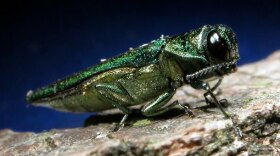Most a bleak picture for the Great Plains a century from now: It will likely be warmer and the air will be richer with carbon dioxide. Though scientists don鈥檛 yet know how exactly the climate will change, new studies show it could be a boon to some invasive plant species.
A growing problem
Ask most Midwestern and Rocky Mountain ranchers about the weeds currently causing them to pull out their hair and be prepared for . It could be cheatgrass in Nebraska, or red brome in Utah, or yellow starthistle in California. Depending on the plant, cattle either don鈥檛 want to eat it or could get sick if they ingest it. And getting rid of these plants is expensive.

But could climate change exacerbate an already thorny problem for ranchers? In 2005, U.S. Department of Agriculture researcher set out to document what effect climate change will have on large swathes of grassland, focusing in on a noxious weed called .
For about eight years Blumenthal and his team in the Wyoming grassland. A heating apparatus kept test plots warmer than normal. Pipes pumped carbon dioxide into the air surrounding the toadflax. The warming and CO2 weren鈥檛 set at doomsday levels, but rather conservative levels Blumenthal says the plains could see within a century. Under those conditions, Dalmatian toadflax flourished, growing in size 13-fold and producing more seeds.
鈥淭he simplest reason that invasive species are likely to do well under future conditions is that they are pretty much by definition good at dealing with change,鈥� Blumenthal said.
That鈥檚 why Dalmatian toadflax could be emblematic of an even larger problem. Invasive species are invasive because they can adapt quickly. Similar field studies across the country have shown other nasty weeds do well in warmer, more CO2-heavy conditions. were published in the journal New Phytologist late last year. He says there is a trend toward global climate change increasing invasion, but scientists need more data to make solid predictions.
鈥淭here are going to be cases of invasive species, some of which we care a lot about, becoming much more problematic, and there are going to be cases of invasive species retreating from where they now exist,鈥� Blumenthal said. 鈥淲e don鈥檛 know enough to say how common this is going to be yet.鈥�
"The simplest reason that invasive species are likely to do well under future conditions is that they are pretty much by definition good at dealing with change."
Dalmatian toadflax is just one piece of a much larger ecological puzzle. What will America鈥檚 grasslands look like a century from now? The answer to that question affects ranchers across the Midwest, who will face expensive headaches when weeds out-compete native grasses.
Fighting a losing battle
In the summer, one hillside of Ellen Nelson鈥檚 small ranch near Bellvue, Colo., turns bright yellow. The culprit is the tall, rubbery stalks of Dalmatian toadflax. It first shot out its showy, golden flowers more than a decade ago on her property where she raises grass-fed beef. And it is a pain. It crowds out native grasses that her cattle actually like to eat.
鈥淚t鈥檚 such a tough, waxy plant that by the time it really gets going you can鈥檛 get the herbicide in it,鈥� Nelson said.
The expensive herbicide is a relatively new weapon for Nelson. It has already cost her thousands of dollars. At first, she tried pulling the toadflax by hand, but the roots go deep and they can quickly regenerate. Then she brought in hundreds of weevils -- they burrow deep and weaken the plant, failing to kill it outright. Lately, she鈥檚 been putting her faith in her steers, convincing them toadflax doesn鈥檛 taste so bad.
鈥淵ou kind of have to teach them about a new plant,鈥� Nelson said. 鈥淚鈥檝e gotten some of them to eat some, but in general, that鈥檚 a hard one.鈥�
Each method has only worked marginally well. Nelson admits, so far, the toadflax is winning. As time progresses and climate change takes hold, it鈥檚 likely to only get worse, not just for Nelson, but for ranchers across the Midwest and Rocky Mountain regions.
鈥淲e are just treading water at the moment,鈥� said Steve Ryder, coordinator of .
Like managers in most states, Ryder鈥檚 focus is on keeping new weeds from creeping in. If he has time left over from that battle, he goes after smaller populations that are quickly becoming problems, almost like stamping out spot wildfires. He鈥檚 already stretched thin and some weeds have gained a foothold.
鈥淚f climate change is going to accelerate that, then we need to decide whether to accelerate the response,鈥� Ryder said.
Rancher Ellen Nelson is already formulating this year鈥檚 plan of attack against Dalmatian toadflax. It鈥檒l likely be a mix of herbicide and burrowing bugs. The toadflax has criss-crossed her property, seeds tumbling downhill into new areas.
鈥淢aybe we鈥檙e going to learn how to live with some of these weeds,鈥� Nelson said. 鈥淭hat might be heretical to say.鈥�
But if the climate gets more and more hospitable to noxious weeds, it鈥檚 heresy that many of her fellow ranchers will have to get used to.
A spreading concern
Dalmatian toadflax has spread into 32 states across the U.S.






